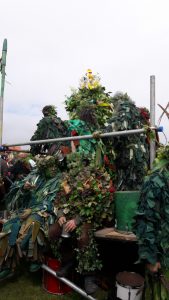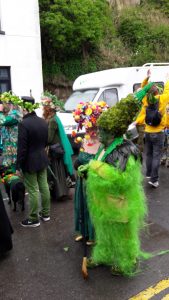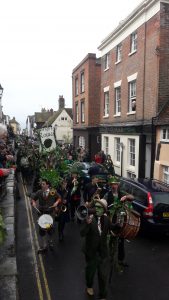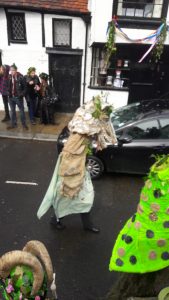Following on from Sam’s post about folk horror and its recent revival, I thought I would write about my attendance of the Jack-in-the-Green festival in Hastings. This takes place around May Day and, as well as the ubiquitous May Pole, the celebrations build to the Jack being beaten in order to bring in summer. It is traditionally a raucous affair (which I can attest to). The Jack surrounded by his bogies is paraded through the town up onto a hill top. Accompanying him on his journey are Morris dancers, animal-headed people, and a plethora of people in green.
You can see the Jack in the photograph on the right up on the plinth surrounded by his followers prior to being beaten. I am assured that they take the gentleman out of the Jack before they start the beating. According to the Jack-in-the-Green website, this tradition started in the 16th and 17th century and was carried on in Hasting until 1889, before being revived in 1983. This is also confirmed by the Company of the Greenman.
However, as with many folk revivals, what it means and where it originates from is something that depends on the person discussing it. Some argue that it harks back early Pagan behaviours which have continued to exist under the guise of Christianity. Others think it is actually a Christian folk festival that evokes English sensibilities. In all honestly, I am inclined to think that its true meaning is in the pleasure of ritual and tradition. It creates cohesion, identity, and is a great excuse for drinking whiskey at 10 o’clock in the morning. (As the pictures show, the weather was not excellent).
weather was not excellent). The British may be known for being reserved but I think we secretly enjoy dressing up and letting our hair down. Putting on face paint allows us to lose our inhibitions and gives us a day off from the strictures of polite decorum. I thoroughly enjoyed seeing some rather bemused tourists getting their noses greened by buxom wenches in tight-laced bodies. Each year, the festival is renewed, much like the seasons and the performance of this ritual brings much pleasure. I’d love to see more folklore(ish) events taking place.
The British may be known for being reserved but I think we secretly enjoy dressing up and letting our hair down. Putting on face paint allows us to lose our inhibitions and gives us a day off from the strictures of polite decorum. I thoroughly enjoyed seeing some rather bemused tourists getting their noses greened by buxom wenches in tight-laced bodies. Each year, the festival is renewed, much like the seasons and the performance of this ritual brings much pleasure. I’d love to see more folklore(ish) events taking place.
I was also pleased to see a wolf amongst the rev ellers. As Sam’s post about the English eerie and (were)wolves discusses, an engagement with our hidden or lost national past is also a way of acknowledging the cruelty we have enacted on the natural landscape. Deforestation and the destruction of indigenous animal populations haunts the landscape as much as human-on-human violence. This pale wolf, walking along an ancient road, reminds us of what we lost and what may return in a truly uncanny way.
ellers. As Sam’s post about the English eerie and (were)wolves discusses, an engagement with our hidden or lost national past is also a way of acknowledging the cruelty we have enacted on the natural landscape. Deforestation and the destruction of indigenous animal populations haunts the landscape as much as human-on-human violence. This pale wolf, walking along an ancient road, reminds us of what we lost and what may return in a truly uncanny way.
 To end on a lighter note, here’s a picture of me in my May Day get-up looking suitably like someone who might entreat a policeman to climb into a giant wicker structure. (And apparently enjoy it).
To end on a lighter note, here’s a picture of me in my May Day get-up looking suitably like someone who might entreat a policeman to climb into a giant wicker structure. (And apparently enjoy it).

Hi Kaja,
This is absolutely brilliant and your costume is very fetching indeed!! There’s quite a lot about this festival in my Oxford Dictionary of English Folklore but it claims it is an urban street custom that was enacted on May Day by chimney sweeps who dress up as Lords and Ladies for the event and follow the Jack- o-Green (a man inside a wood or basket frame from his head to his ankles on which was fixed an abundance of greenery and flowers). The visual effect is a bush on feet which danced through the streets. It reminds me of the Shadow Queen festivities in Eastern Europe, which Marcus draws on. She is paraded through the streets dressed in the villagers clothes and burnt in effigy in the spring. The stuff of folk horror indeed but also bags of fun!! Do you know any origins of the wolf costume? There is quite a lot on animal mummers in my book and there was a crow in St Albans (which I posted).
Thank you! I only had an evening to come up with the costume. Luckily my aunt brought along a spare headdress! There were chimney sweeps in the parade and I think that may link back to the urban connection. A lot of the people I spoke to felt that it was Pagan but I think it’s probably a little more recent. I think I need the OED of English Folklore. It sounds like a very useful reference book. I don’t know about the origins of the wolf costume – apparently it was a new edition. I suggested to my fellow revellers that just as they were bringing back old traditions, the wolf represented the return of lost species but that is just my reading. There was a crow walking with the wolf as well – perhaps a connection? There were also some lovely French minstrels. I could imagine minstrels coming over in the middle ages to play in Hasting as well.